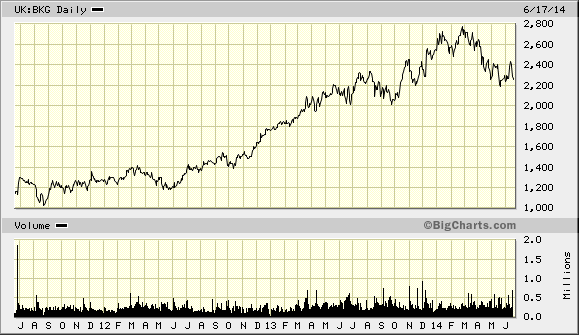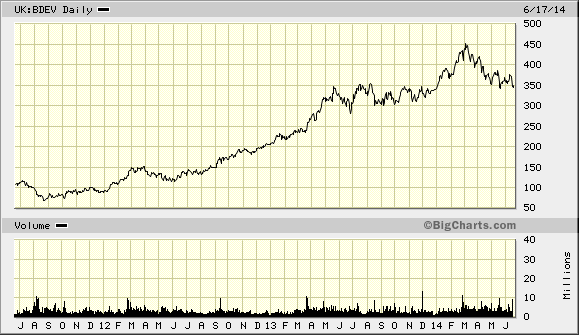Want to know which way the housing market is headed?
Take a look at the builders. They’re a pretty reliable indicator.
And here’s the thing – having peaked in the spring, they’re now in a bear market that’s starting to look entrenched.
Does this mean our great post-financial-crisis house-price boom is now over?
It could well be.
I should say, I don’t own any shares in any of the building companies and, at present, I’ve no plans to buy any. But I do like to keep an eye on what they’re doing.
Housebuilders are very good bellwethers for the property market
I’ve found likes of Barratt (LSE:BDEV), Bovis (LSE:BVS), Taylor Wimpey (LSE:TW) and the Berkeley Group (LSE:BKG) all work extremely well – for obvious reasons – as bellwethers for the housing market.
For example, they peaked in early 2007 and were in pronounced downtrends long before the global financial crisis and the slowdown of housing market really got going almost a year later.
They bounced in late 2008 and then meandered sideways for a couple of years. By 2011, they were all moving up.
In 2011, there was a wobble as panic set in that Greece was about to become the catalyst for the second leg of the global financial crisis, but that proved to be a bear trap and since late 2011 – a good year or more before house-price hysteria gripped the nation once again – they have been trending up strongly.
Something similar happened during the last major crash of the early Nineties. The house-builders told us a bust was coming, the bust came and the housebuilders began to rally long before house prices started to pick up steam. I wrote about this relationship in great detail back in April – read it here.
It’s interesting to note, by the way, how far off their 2007 highs many of the builders still are. Barratt – almost 1,300p in 2007; 349p today. Taylor Wimpey – over 500p in 2007; 103p today. Bovis – 1,200p in 2007, 732p today. Compare this to the FTSE 100 which is trading at about the same price (6,754 was the 2007 high and, indeed, yesterday’s close).
The Berkeley Group – which is more focused on London – has dramatically outperformed the other builders, and sits almost 20% above its 2007 highs. This reflects Britain’s two housing markets – London and everywhere else.
Even London builders are in a downtrend
But even Berkeley is in a clear downtrend. It peaked in late February at 2,800p and closed yesterday at 2,261 – about 20% off its highs. 20% is what defines a bear market.
Here you can see the incredible run up Berkeley had from late 2011 – almost tripling from its low at 1,000 – and the downtrend that has begun in these last few months. I see 2,200 and 2,000 as big levels of support. If they don’t hold, I’d start to have concerns about the housing market. What is currently a wobble (lending tightening, asking prices flattening out, new enquiries falling back, etc) may turn out to be something bigger.

The correlation between Barratt – the UK’s largest builder – and the housing market is even more pronounced. Barratt’s share price more than quintupled from its 2011 low to its 2014 high at 450p. Now sitting at 350p, it’s just over 20% off its highs.

300p is the big line in the sand for Barratt, as I see it. If 300p holds, then the slowdown we are seeing in housing is just a wobble; if it doesn’t, it’s the start of something bigger.
But the same goes for all of them – Bovis, Taylor Wimpey, Telford (LSE:TEF), Persimmon (LSE:PSN) – they’re all somewhere around that 20% off their highs area. Redrow (LSE:RDW), in particular, looks ugly to me.
Of course, most of us don’t have plans to buy a new home built by Barratt, Bovis or the Berkeley Group. If I see a Victorian house for sale that I like the look of and make a low bid based on the fact that Barratt is in a bear market, I imagine I would be met with frowns of incomprehension and probably escorted fairly quickly off the premises.
But building stocks are nimble frigates, whereas houses are slow-moving aircraft carriers. Building stocks lead and housing follows.
Is the housing market about to turn down?
Well, I can list a hundred reasons why it should, especially in London. House prices bear no relation to earnings; interest rates aren’t going to stay low forever, and when they do rise many people are going to find themselves over-leveraged and unable to service their debts; as the pound gets stronger overseas buyers could become net sellers; there is a vast supply of new (and ugly) flats being built in London that will soon come to market; the higher house prices rise, the more likely it is we’ll see a mansion tax; lending is tightening and on and on.
But my experience of 44 years as a Londoner is that London house prices always seem to defy the bears. There is the occasional small window of opportunity and that is it. Even in the bear market of the early Nineties, nice homes in nice streets held their value. Like the Terminator, London house prices are indestructible no matter what you fire at them.
Outside of London, that’s a different story, of course.
At present, my interpretation is that we’ll see a levelling off. Recent gains will be consolidated, asking prices will become more ‘realistic’ to use estate agents’ jargon, and the market will flat line. That s how I interpret the builders’ charts.
A full-blown crash? I doubt it very much.
But ask me again if Barratt breaks 300p and the Berkeley Group 2,000p. Then you’ll get a different answer.
• Dominic Frisby’s Bitcoin – the Future of Money? is out soon. But you can still get your name in the back.
Category: Market updates

